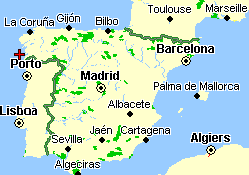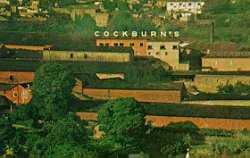
Good Cooking since 1995
A Pint of Port!
"A pint of old Port and a devilled biscuit can hurt no man." Dr. Swizzle - Handley Cross by R. S. Surtees
Port --- A sweet fortified wine from Portugal's upper Douro Valley; shipped from
Porto, see map, brandy is added to partially fermented grape juice, stopping fermentation
and producing a strong sweet wine that is then matured for years!
The information below comes from a variety of sources and has been arranged in an order that I hope is informative. The sources are from: Port, an Introduction to its History and Delights by Wyndham Fletcher, Sotheby Parke Bernet 1978; Sandeman which is imported by the Seagram Wines Co., New York, N.Y.; and Imediata - Comunicações e Multimédia, SA. Photo credits to Imediata, LineOne UK., Good Cooking, Inc. and Port, an Introduction to its History and Delights by Wyndham Fletcher

(Mapblast Supplied Map) Port, the famous sweet fortified wine of the Douro River Valley in Portugal, has long been the classic way to end a meal and celebrate an evening. Port is a sweet red wine with about 20% alcohol (as opposed to table wine which is usually about 13%) and rather low acidity and tannin. Ideally a good Port should have a rich spicy flavor and in spite of its 20% alcohol, taste very smooth. The Port vineyard zone of the Douro River Valley, was officially demarcated by the Portuguese in the 18th Century. It covers just over 1,000 square miles, with less than 15% of that area being planted in vines. Winters in the Douro are cold, wet and often snowy, while the summer season sees temperatures in excess of 100øF. The hardy vines of the Tinta Francisca, Mourisco, Tinto Cao, Tinta Roriz, Alvarelhao, Bastardo, Tourriga Nacional, and Tinta Barroca grapes endure this harsh environment to produce wines of great richness and intensity. The recommended and authorized Red Grape varieties used in making Port include Bastardo, Donzelinho Tinto, Mourisco, Tinto Cao, Tinta Francisca, Tinta Roriz, Touriga Francessa, Touriga Nacional, Cornifesto, Malvasia Preta, Mourisco de Semente, Periquita, Rufete, Samarrinho, Tinta Amerela, Tinta da Barca, Tinto Barroco and Touriga Brasileira. Port is created in a unique way that captures the fruit and flavor of the ripe grapes in wines that possess extraordinary longevity. During fermentation, prior to reaching the point where all of the natural grape sugars have been converted into alcohol, high-proof brandy is added to the vats to stop the fermentation. This leaves a wine with great depth of color and a high natural sweetness.

(Cockburn's Port House) After fermentation is complete, the wines are transported to "lodges" where they rest in large oak casks called "pipes." Vintage Ports are very grapey. This grapiness comes from the practice of bottling these wines after they have spent 2 years in barrel. Vintage Ports are to be held in the bottle for a long time, ten years considered being just a start while truly great vintages can require 20 years and more to reach optimum maturity. They keep their grapey flavor and, through bottle aging, develop bottle bouquet, a special quality found only in bottle aged wines. It can take many years for vintage Ports to become smooth if they have some tannin when they are bottled.
Ruby Ports are generally young wines that have had the chance to assimilate the brandy which was added during fermentation, but have not lost their youthful ruby-red color. Fruity on the nose and with the vitality of young wines, they tend to be very fresh in the mouth. They are an average of 2 years old.
Tawny Ports are aged a long time in wooden barrels, spending 3 or 4 years in casks. They tend to lose most of their fruit and the normal deep red color becomes more of an amber hue (which gives the wine its name) and acquire a nutty character. They should be very smooth when bottled. These may be wines whose bouquet has some trace of the young wines, but also many of the characteristics of Dated Ports or Ports with an indication of age, or "Ports of the Vintage".
Wood Ports represent the finest of Ports. They have been exclusively aged in barrel and not in bottle like Vintage Port. White Ports: there are several styles of White Port, namely those associated with different degrees of sweetness and the manner by which they are made. In addition to the traditional styles, there are those with a very floral and highly complex nose and a minimum alcohol content of 16.5% (Light Dry White Port), of interest to those who are looking for a less alcoholic Port.

(Terraced Vineyards) "Vintage Ports" are wines of superior quality, produced in exceptionally good years from select areas within the region. Made from wines produced in a single year, they are kept in wood for two to three years before they are bottled. Presenting outstanding flavor characteristics, they must be very full-bodied and deep in color when they are declared (two years after they are made). Aging in bottle endows them with the smoothness and elegance that gradually takes over from their initial astringency. As they age, their bouquet becomes balanced, complex and highly distinctive.
Vintage Ports that have spent some years in bottle are associated, on the nose, with toasted aromas (chocolate, cocoa, coffee, cigar boxes, etc.) and with spices (cinnamon, pepper) and occasionally, fruits. "L.B.V.(Late Bottled Vintage)" are also wines from a single year. They appear in years of excellent quality and are aged longer in wood than in the case with Vintage Port. They are bottled between the fourth and sixth year after they are made. Red in color, their flavor characteristics endow them with elegance and distinction. Full-bodied, smooth and with a more or less fruity bouquet, they may develop to a certain degree depending on how long they are kept in wood. Usually these wines are less astringent and full-bodied than Vintage Ports of the same year, yet equally harmonious; their smoothness and elegance varies according to the individual style of the producer. "Crusted Port" Not a vintage, crusted port matures in the bottle. It is a young blended wine which will be ready to drink in 3 years at a reasonable price.
In terms of sweetness, Port Wine can be very sweet, sweet, semi-dry, dry or extra dry. It is the winemaker who determines just how sweet a Port Wine will be according to when he interrupts the fermentation.

(Pumping over) "Dated Ports" are wines from a single year that age in wood for several years and can only be sold after they have attained 7 years of age. While aged in wood, their young, fruity and fresh aromas develop through oxidation to create a bouquet marked by the aroma of dried fruit, the distinct and pleasant hint of ethyl acetate and aromas of toasting, wood and spices. As they age they acquire an increased smoothness and their bouquet becomes more harmonious and complex. They become golden in color, with greenish tints in very old wines.
Port Wines with an "Indication of Age" are similar in style to Dated Ports but, unlike the latter, are blended from wines of different years. The age that is given on the label expresses the nature of the wine as regards the characteristics that are conferred on it through aging in wood. Thus, a "10 years of age" wine has the color, aroma and typical taste of a wine that has aged in wood for 10 years. The authorized age indicators are: 10 years, 20 years, 30 years and more than 40 years. As with Dated Ports, their bouquet is characteristic of the oxidation process: dry fruits, toasting, spices and the characteristic hint of ethyl acetate that is more marked in older wines. In the mouth they are smooth and harmonious and their bouquet lingers greatly in the mouth.

(Railroad Trestle in the Douro)
Glossary of some Port Terms:
Baumé - the density scale used to determine the degree of sweetness of musts and sweet wines.
Benefício - the Portuguese expression used to describe the adding of grape brandy to fermenting wine.
Bouquet - the set of aromas that characterize a wine and that develop especially during fermentation and aging.
Crushing - action of smashing the grapes to release their juice.
Destemming - removing the stems from the grapes .
Draw off - to drain the juice from the tanks in which the wine is made, leaving the pomace behind.
Fortified wine - a special type of wine where, not excluding other situations duly defined in European Union legislation, the natural fermentation of the must produced by grapes is interrupted by adding grape brandy, as in the case of Port Wine. Lot - the wine that is obtained by blending two or more wines.
Maceration - the prolonged contact of the must with the solid grape matter with a view to extracting the compounds that are responsible for giving it its color and aromas.
Must - unfermented grape juice.
Must fermenting - grape juice in which the alcohol it contains is fermenting.
Pomace - the solid matter from the crushed grapes that is impregnated with wine after the wine has been drawn off from the tanks in which it made or the dry matter that remains after the wet pomace has been pressed.
Pumping over - the procedure that consists of pumping the fermenting must from the bottom of the tank and pouring it in at the top of the same tank so as to air the must and encourage the extraction of the compounds responsible for giving it its color and to make it more homogeneous.
Racking from the lees - the process of transferring wine from one cask to another for purposes of separating it from the deposit it throws (lees) and airing it.
Treading - crushing the grapes by foot.

(Warre's Warrior Porto Bottle and cases of Dow's Single Vineyard Quinta do Bomfin)
